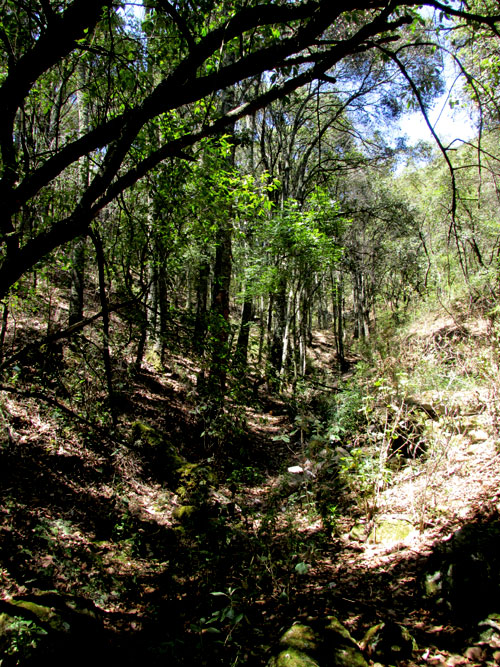Excerpts from Jim Conrad's
Naturalist Newsletter
from the March 23, 2009 Newsletter, issued from the forest near Natchez, Mississippi; elevation ~400ft (120m), ~N31.47°, ~W91.29°:
BLACK CHERRY TREES FLOWERING
When I passed through here last June I photographed cherries on the Black Cherry tree, PRUNUS SEROTINA, next to my trailer. That picture appears in the next section. This week the same tree has been full of flowers, setting the stage for June, 2009 cherries. Below you can see flowers and leaves on the same branch as below:
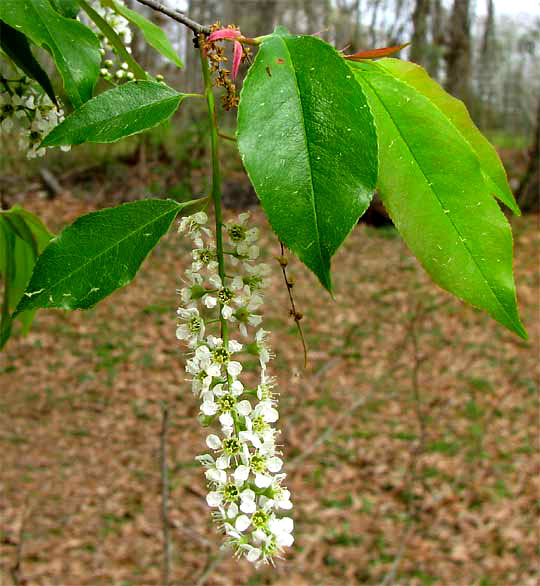
Below you see a single flower in the panicle of flowers shown above. What an elegant little blossom it is, its five white petals affixed so geometrically around the rim of the cuplike hypanthium, male stamens also arising from the rim, alternately bending toward the flower's center or leaning away from it, and in the center of the hypanthium cup the pale, irregularly shaped thing is the stigma atop the female pistil. Below the stigma lies the green ovary, which later will mature into the cherry.
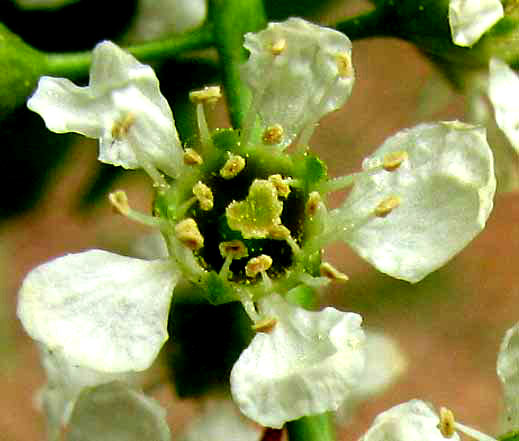
That cuplike hypanthium is worth fixing in your mind because it's so typical of many genera in the huge Rose Family to which Black Cherry trees belong. Recently we've seen hypanthia in plum flowers, also members of the Rose Family. Most flowers have stamens and petals attached at the base of the pistil, not from the hypanthium's rim, and with nothing like the hypanthium, which is like a little bowl holding a single cherry inside it.
from the June 16, 2008 Newsletter, issued from the forest near Natchez, Mississippi; elevation ~400ft (120m), ~N31.47°, ~W91.29°:
BENEVOLENT BLACK CHERRIES
Right above my porch a good-sized Black Cherry tree, PRUNUS SEROTINA, has been providing juicy black cherries to the surrounding wildlife community ever since I got here. You can see some black cherries below:
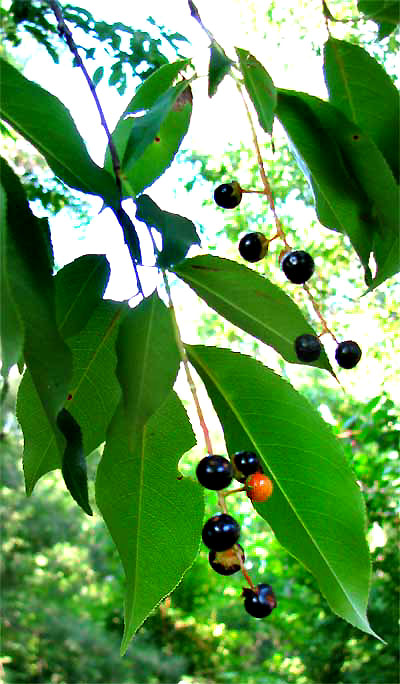
Before the cherries ripen they're red, and before turning red they're green. Mature cherries are only about ¼-inch across and their pits are relatively large, so humans usually don't bother with them, despite their being edible. Juicy, ripe fruits leave a residual slightly bitter taste in your mouth but fruits that have dried on the tree to the point of being wrinkled are almost like sweet little raisins. In the past brandy was sometimes flavored with black cherries. When you pick and eat wild black cherries they impart a lovely, hard-to-wash-off burgundy stain on your fingers and lips, like pokeberries.
I call my Black Cherry tree "benevolent" because each morning and late afternoon its branches are absolutely busy with birds who eat large numbers of its fruits. Mockingbirds, Brown Thrashers, Bluejays, Cardinals, Orchard Orioles, Robins, Red-bellied Woodpeckers... Even insect eaters like Prothonotary Warblers and White-eyed Vireos range through the tree, maybe preying on insects drawn to the juicy fruits or maybe just enjoying being part of the bustling Black Cherry bird community.
Black Cherry trees produce wonderful wood much used in high-end furniture, and that's caused them be rarer than they used to be. I know some folks who heard how many hundreds of dollars they could get if they sold the big Black Cherry standing over their house, so they immediately sold it. But then they found that their backyard was so hot and glaring in the summer that it wasn't fun to go outside anymore. So they sold their house and never were happy in their new home. Serves them right, as far as I'm concerned.
For my part, every day I feel as if somehow the beautiful Black Cherry's benevolence seeps into me. When I sleep beneath the mosquito net on my new porch's floor with the Black Cherry nearby, it's almost as if just by being close to this wonderful tree I grow more beautiful and benevolent myself.
from the February 23, 2009 Newsletter, issued from the forest near Natchez, Mississippi; elevation ~400ft (120m), ~N31.47°, ~W91.29°:
BLACK CHERRY BEGINNINGS
When I passed through here last June I photographed cherries on the Black Cherry tree, PRUNUS SEROTINA, next to my trailer. That picture is shown in the previous section. Right now that same tree is leafless, but its buds are expanding, even bursting, as shown below:
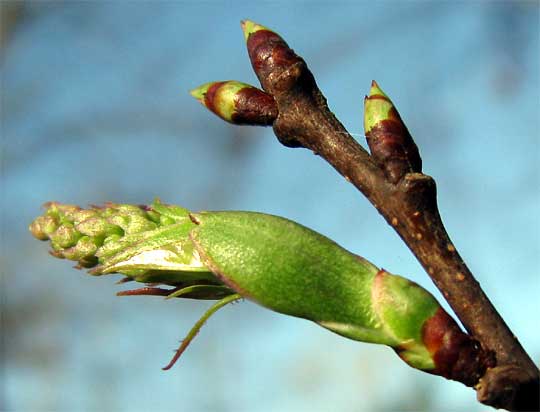 .
.
In this week's picture the three buds at the twig tip are leaf buds. The bud scales' green patches show how the buds have enlarged, exposing tender new growth that earlier was protected by the smaller, dark chestnut scales. Before long leaf-bearing stems will emerge from these buds.
Below the three leaf buds a flower bud already has burst. The green, granular items at the far left are future flowers that will be held in an elongate, dangling cluster called a raceme. By the time the flowers are open leaves will have appeared. During warm, sunny days, you'd be surprised how fast the buds are enlarging, and how much farther from the flower- bud the future raceme of pretty white flowers emerges.
from the April 28, 2013 Newsletter issued from the Frio Canyon Nature Education Center in northern Uvalde County, southwestern Texas, on the southern border of the Edwards Plateau; elevation ~1750m (~5750 ft); N29.62°, W99.86°; USA
ESCARPMENT BLACK CHERRIES FLOWERING
At the base of a twenty-ft-high limestone cliff rising beside the little Dry Frio River behind the cabin, a tree turned up that I knew very well from back East, but it had never occurred to me that it might also be found here. You can see its leaves and flowers below:

That's the Black Cherry, looking healthy and at home here despite our proximity to Mexico's vast Chihuahuan Desert just west of us, and despite the long-term drought we're experiencing now.
The raceme of white flowers in the picture is exactly like those on the big Black Cherry next to my old hermit trailer back in Mississippi. However, the leaves of our Dry Frio tree are a bit different. Their smallish blades are held on petioles much longer than I'm used to, plus the leaves' margins are more coarsely toothed, or serrated, than leaves on trees I'm familiar with back East. In the picture at the top of this page you can compare the leaves in the above picture with those on the tree next to my hermit trailer.
It turns out that here in southwestern Texas our Black Cherries belong to a different variety than the typical one back East. In fact, four varieties of Black Cherry, Prunus serotina, are recognized for North America, with others farther south. Black Cherries occur in much of the Mexican highlands as well as Guatemala. You can see a distribution map showing many tropical-American "islands" of Black Cherry populations, as well as an isolated population here on the Edwards Plateau, here.
Our variety of Black Cherry endemic to the Edwards Plateau region of southwestern Texas is called the Escarpment Cherry, PRUNUS SEROTINA var. EXIMA. It's distinguished physiologically from other Black Cherry varieties by almost or entirely hairless leaves with more coarsely toothed margins, longer petioles, and, growing up to 50 ft tall (15m), a potential height intermediate that of the taller Eastern Black Cherry (P. serotina var. serotina) and the shorter Southwestern varieties, virens and rufula.
entry from field notes dated July 2, 2022, taken on Cerro de la Cruz, at an elevation of ~2885m (~9465 ft), just south of the community of El Pinar, Amealco de Bonfil, Querétaro, MÉXICO, (~N20.17°, ~W100.17°)
BLACK CHERRY IN UPLAND CENTRAL MEXICO

At the mouth of a valley opening toward the east and mantled with oak forest, a firewood gatherer had chopped down a tree that fell onto a smaller tree, whose trunk splintered, causing the smaller tree to fall across the dry arroyo I was following downslope along the arroyo bed. The entire larger tree had been cut up and carried away, apparently the traditional way, on the back, with a strap around the front of the head, but the smaller tree still was there, leafed out and producing the cherries shown above.

The leaves confirm that this is the Black Cherry, Prunus serotina, we've met several times. We've also seen that Black Cherries occur in various "island populations," as seen on Wikipedia's USGS distribution map. Among those scattered locations, several varieties and subspecies have been designated. So, which do we have here?
The Flora del Bajío, which treats members of the Rose Family in our Bajío region of semiarid, upland, central Mexico, says that here it's possible to encounter three Prunus serotina subspecies. There's subspecies virens, distributed from the southwestern US through the mountains to this general area; subspecies capuli, found from here south to about Mexico City, and eastward into Veracruz, and; the type subspecies, ssp. serotina, found all the way from Canada throughout upland Mexico into Guatemala.
This curiously overlapping set of distributions is explained in the Flora by the fact that for a long time people have eaten the cherries, often cultivated the trees, and carried about the seeds. It also says that plants with intermediate features are not lacking.
In the dichotomous key the Flora del Bajío provides for differentiating the three subspecies in our area, the most important feature used is the relative sizes of the fruits, inflorescences and leaves. Size often isn't a dependable feature, but maybe here it's useful.
For instance, the easiest subspecies to separate from the others is ssp. capuli, because its parts are all larger and its leaves proportionally narrower than on the others. Most of its mature leaves are 2.5 to 4.5 times longer than wide, as opposed to 1.8 to 2.5(3.5) for the others. In our above leaf picture you can see that the blades of our tree's leaves are a little over 3 times longer than wide. That shape falls in the center of possibilities for ssp. capuli, while such leaves also exceptionally can be found in the other two subspecies.
In ssp. capuli, the mature fruit usually expands to more than 10 mm in diameter, while in the other two, the size ranges from 8 to 11mm. In our above fruit picture, comparing the fruits' diameter with that of my small finger, and finding that my small finger at its first joint is 19mm wide, while on my laptop screen it appears to be 25mm, using the ratio and proportion formula, this tree's mature cherries appear to reach 13mm in diameter. That's a solid vote for ssp. capuli.
The Flora del Bajó's distribution maps for the three subspecies places a dot exactly at our location at Amealco for capuli, but here in Querétaro state subspecies serotina is shown only at the opposite end of the state, in the north, while virens occurs near San Juan del Río also to our north, but hasn't been documented exactly here.
So I'd say that here we have a fairly good representative of Prunus serotina ssp. capuli. The Flora describes this subspecies as being common, mainly in disturbed oak and conifer forests at elevations of 1950-2650m (6400-8700 ft).
Here's our tree's splintered trunk, with vigorous sprouts arising from the base, growing on the arroyo's steep slope:
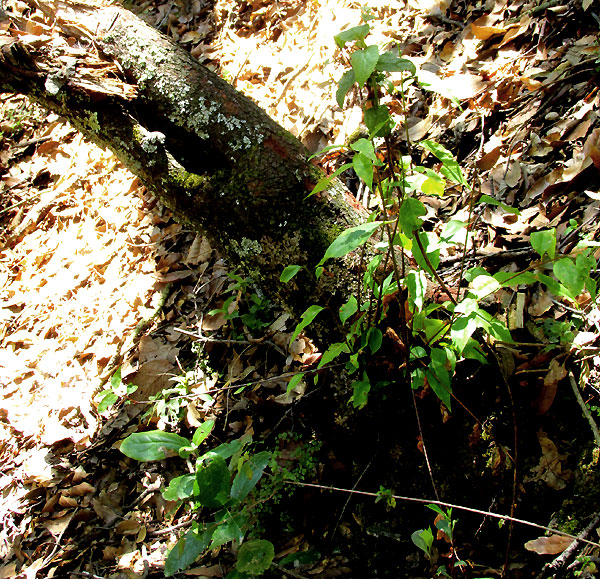
Here's the steep arroyo formed where Cerro de la Cruz meets another peak, as seen from the fallen Black Cherry:
